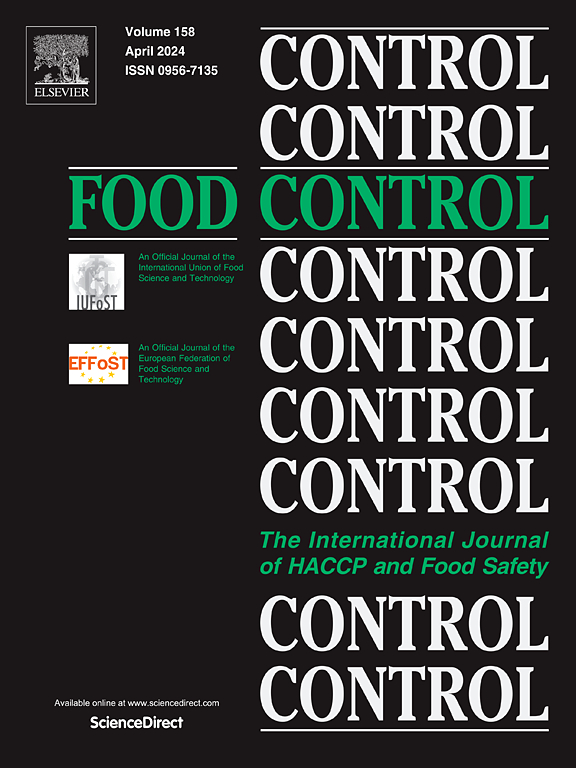Multi-residue analysis of pesticides in guava: A case study from Egyptian markets with dietary risk implications
IF 6.3
1区 农林科学
Q1 FOOD SCIENCE & TECHNOLOGY
引用次数: 0
Abstract
Pesticide residues in fresh produce present ongoing challenges for food safety, particularly in regions with intensive agricultural practices. This study assessed pesticide contamination, regulatory compliance, and dietary risk in 574 guava (Psidium guajava) samples collected from Egyptian markets between 2021 and 2023. Multi-residue analysis using LC-MS/MS and GC-MS/MS detected pesticide residues in 76.1 % of samples, with 31.2 % exceeding established Maximum Residue Limits (MRLs). Organophosphate and pyrethroid insecticides, including chlorpyrifos, dimethoate, cypermethrin, and lambda-cyhalothrin, dominated the residue profile. Several of these compounds are banned or restricted under international regulations, indicating persistent gaps in local pesticide management. Fungicides such as carbendazim were frequently detected but generally remained within legal limits. Despite the high incidence of contamination and regulatory violations, dietary risk assessment based on Estimated Average Daily Intake (EADI) revealed that exposure levels were well below toxicological concern thresholds. All residues accounted for less than 0.001 % of their respective Acceptable Daily Intakes (ADIs), suggesting negligible chronic health risks from guava consumption. While the findings indicate low immediate dietary risk, the high rate of MRL exceedances raises concerns regarding compliance, trade barriers, and long-term pesticide stewardship. The study highlights the need for enhanced regulatory enforcement, farmer education, and adoption of Integrated Pest Management (IPM) to reduce reliance on hazardous pesticides. This research provides critical insights into pesticide residue dynamics in Egyptian guava production. It underscores the importance of balancing agricultural practices with food safety standards to protect public health and sustain market access.
番石榴中农药的多重残留分析:来自埃及市场与饮食风险影响的案例研究
新鲜农产品中的农药残留对食品安全构成了持续的挑战,特别是在集约化农业生产的地区。本研究评估了2021年至2023年期间从埃及市场收集的574份番石榴(Psidium guajava)样本的农药污染、法规遵从性和饮食风险。采用LC-MS/MS和GC-MS/MS进行多残留分析,检出的农药残留量为76.1%,其中31.2%超过规定的最大残留限量(MRLs)。有机磷和拟除虫菊酯类杀虫剂,包括毒死蜱、乐果、氯氰菊酯和高效氯氟氰菊酯,在残留剖面中占主导地位。根据国际法规,这些化合物中有几种是被禁止或限制的,这表明当地农药管理存在持续的差距。多菌灵等杀菌剂经常被检测到,但通常仍在法定范围内。尽管污染和违反法规的发生率很高,但基于估计平均每日摄入量(EADI)的饮食风险评估显示,暴露水平远低于毒理学关注阈值。所有残留物占各自可接受每日摄入量(adi)的比例都不到0.001%,这表明食用番石榴的慢性健康风险可以忽略不计。虽然研究结果表明直接饮食风险较低,但MRL超标率高引起了对合规、贸易壁垒和长期农药管理的关注。该研究强调需要加强监管执法、农民教育和采用有害生物综合管理(IPM),以减少对有害农药的依赖。这项研究提供了关键的见解农药残留动态在埃及番石榴生产。它强调了平衡农业做法与食品安全标准以保护公众健康和维持市场准入的重要性。
本文章由计算机程序翻译,如有差异,请以英文原文为准。
求助全文
约1分钟内获得全文
求助全文
来源期刊

Food Control
工程技术-食品科技
CiteScore
12.20
自引率
6.70%
发文量
758
审稿时长
33 days
期刊介绍:
Food Control is an international journal that provides essential information for those involved in food safety and process control.
Food Control covers the below areas that relate to food process control or to food safety of human foods:
• Microbial food safety and antimicrobial systems
• Mycotoxins
• Hazard analysis, HACCP and food safety objectives
• Risk assessment, including microbial and chemical hazards
• Quality assurance
• Good manufacturing practices
• Food process systems design and control
• Food Packaging technology and materials in contact with foods
• Rapid methods of analysis and detection, including sensor technology
• Codes of practice, legislation and international harmonization
• Consumer issues
• Education, training and research needs.
The scope of Food Control is comprehensive and includes original research papers, authoritative reviews, short communications, comment articles that report on new developments in food control, and position papers.
 求助内容:
求助内容: 应助结果提醒方式:
应助结果提醒方式:


